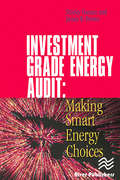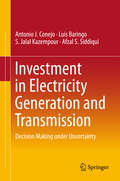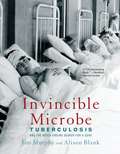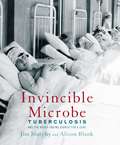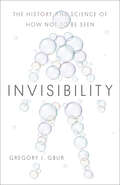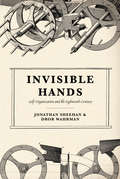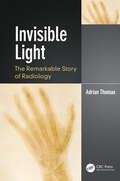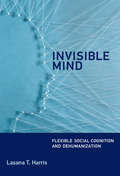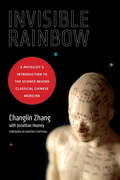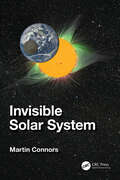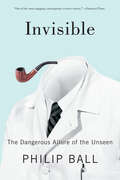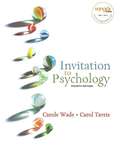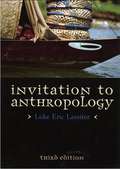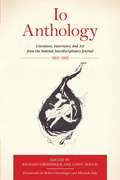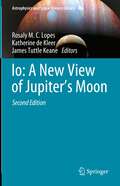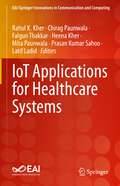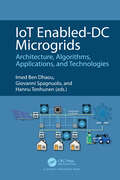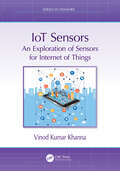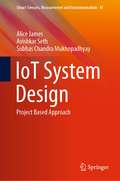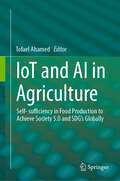- Table View
- List View
Investment Grade Energy Audit: Making Smart Energy Choices
by James W. Brown Shirley J. HansenThis book was written to give energy-involved professionals the tools they need to take their energy audits to the next level, and use them to accurately predict a building's future energy use and true savings potential. Going beyond the conventional energy audit, which can lead to projections which are frequently off by as much as 20%, this book provides detailed guidelines on how to use the new tool, the investment grade audit (IGA), which enables prediction of savings with much greater accuracy. Building on the traditional audit, the IGA requires the addition of a "risk assessment component" which evaluates conditions in a specific building and/or process and reduces the level of uncertainty as to how proposed energy efficiency measures will really behave over time. The authors have covered every aspect of the IGA, including risk management, the "people" factor, measurement and verification, financing issues, report presentation guidelines, and master planning strategies.
Investment in Electricity Generation and Transmission
by Antonio J. Conejo Luis Baringo Morales S. Jalal Kazempour Afzal S. SiddiquiThis book provides an in-depth analysis of investment problems pertaining to electric energy infrastructure, including both generation and transmission facilities. The analysis encompasses decision-making tools for expansion planning, reinforcement, and the selection and timing of investment options. In this regard, the book provides an up-to-date description of analytical tools to address challenging investment questions such as: How can we expand and/or reinforce our aging electricity transmission infrastructure? How can we expand the transmission network of a given region to integrate significant amounts of renewable generation? How can we expand generation facilities to achieve a low-carbon electricity production system? How can we expand the generation system while ensuring appropriate levels of flexibility to accommodate both demand-related and production-related uncertainties? How can we choose among alternative production facilities? What is the right time to invest in a given production or transmission facility? Written in a tutorial style and modular format, the book includes a wealth of illustrative examples to facilitate comprehension. It is intended for advanced undergraduate and graduate students in the fields of electric energy systems, operations research, management science, and economics. Practitioners in the electric energy sector will also benefit from the concepts and techniques presented here.
Investor Relations and ESG Reporting in a Regulatory Perspective: A Practical Guide for Financial Market Participants
by Poul Lykkesfeldt Laurits Louis KjaergaardInvestor Relations and ESG Reporting in a Regulatory Perspective is a comprehensive and detailed practical guide for financial market participants, focusing on the stock market, written for practitioners by practitioners. The main themes of the book include the challenging integration of investor relations (IR) and the non-financial reporting of environmental, social and governance (ESG). Further, the book provides a comprehensive overview of the complex regulatory framework of the European Union (EU) related to the financial markets, including the expected global trends in this area. This includes financial legislation such as MiFID II, MiFIR and MAR along with non-financial legislation like the EU’s taxonomy, CSRD and SFDR. In addition, this book explores the non-financial reporting standards of GRI, TCFD, CDSB, IBC, SASB, IRRC and the upcoming ISSB, and discusses the UN’s Sustainable Development Goals (SDGs). In addition, the book provides a practical guide regarding IR in special situations, e.g. in connection with takeover response manuals, M&A, investor activism, initial public offerings (IPOs), as well companies’ collaboration with e.g. investment banks and corporate finance advisers, financial PR and IR advisers in such situations. The suggested audience of the book includes board members and senior management of in particular listed companies, and companies considering an IPO; professionals working in the fields of IR, ESG and communications; institutional and retail investors; private equity executives; venture capitalists; investment bankers; legal practitioners; accountants and auditors; financial journalists; and politicians. Finally, university and business students may benefit from an insight into the dynamics of the financial markets and the direction they are moving, a possible inspiration for choosing a future career.
Invincible Microbe: Tuberculosis And The Never-Ending Search For A Cure
by Jim Murphy Alison BlankThis is the compelling, suspenseful, down-to-earth story of a killer that has been stalking and doing away with people for thousands of years: Tuberculosis. For centuries TB in many forms was treated with everything from poultices and potions to the king's touch. The microorganism that causes the disease was eventually identified, more effective treatments were developed, and the cure for TB was thought to be within reach. But the TB germ simply will not die; drug-resistant varieties continue to plague and panic the human race. The "biography" of this deadly germ, an account of the diagnosis, treatment, and "cure" of the disease over time, and the social history of an illness that could strike anywhere but was most prevalent among the poor are woven together in an engrossing narrative supported by 70-plus archival prints and photographs. Includes bibliography, source notes, and index.
Invincible Microbe: Tuberculosis and the Never-Ending Search for a Cure
by Jim Murphy Alison BlankThis is the story of a killer that has been striking people down for thousands of years:tuberculosis. After centuries of ineffective treatments, the microorganism that causesTB was identified, and the cure was thought to be within reach--but drug-resistantvarieties continue to plague and panic the human race. The "biography" of this deadlygerm, an account of the diagnosis, treatment, and "cure" of the disease over time,and the social history of an illness that could strike anywhere but was most prevalentamong the poor are woven together in an engrossing, carefully researched narrative.Bibliography, source notes, index.
Invisibility: The History and Science of How Not to Be Seen
by Gregory J. GburA lively exploration of how invisibility has gone from science fiction to fact Is it possible for something or someone to be made invisible? This question, which has intrigued authors of science fiction for over a century, has become a headline-grabbing topic of scientific research. In this book, science writer and optical physicist Gregory J. Gbur traces the science of invisibility from its sci-fi origins in the nineteenth-century writings of authors such as H. G. Wells and Fitz James O&’Brien to modern stealth technology, invisibility cloaks, and metamaterials. He explores the history of invisibility and its science and technology connections, including the discovery of the electromagnetic spectrum, the development of the atomic model, and quantum theory. He shows how invisibility has moved from fiction to reality, and he questions the hidden paths that lie ahead for researchers. This is not only the story of invisibility but also the story of humankind&’s understanding of the nature of light itself, and of the many fascinating figures whose discoveries advanced this knowledge.
Invisible Hands
by Jonathan Sheehan Dror WahrmanWhy is the world orderly, and how does this order come to be? Human beings inhabit a multitude of apparently ordered systems--natural, social, political, economic, cognitive, and others--whose origins and purposes are often obscure. In the eighteenth century, older certainties about such orders, rooted in either divine providence or the mechanical operations of nature, began to fall away. In their place arose a new appreciation for the complexity of things, a new recognition of the world's disorder and randomness, new doubts about simple relations of cause and effect--but with them also a new ability to imagine the world's orders, whether natural or manmade, as self-organizing. If large systems are left to their own devices, eighteenth-century Europeans increasingly came to believe, order will emerge on its own without any need for external design or direction. In Invisible Hands, Jonathan Sheehan and Dror Wahrman trace the many appearances of the language of self-organization in the eighteenth-century West. Across an array of domains, including religion, society, philosophy, science, politics, economy, and law, they show how and why this way of thinking came into the public view, then grew in prominence and arrived at the threshold of the nineteenth century in versatile, multifarious, and often surprising forms. Offering a new synthesis of intellectual and cultural developments, Invisible Hands is a landmark contribution to the history of the Enlightenment and eighteenth-century culture.
Invisible Light: The Remarkable Story of Radiology
by Adrian ThomasThe book is a developed history of the radiological sciences – covering the back-story to Röntgen’s discovery, the discovery itself and immediate reception the early days of radiology leading to classical radiology (the pre-digital world). The 1970s as the ‘golden decade’ of radiology will be covered in detail, with the development of CT, MRI and modern interventional radiology. It will appeal to interested members of the public, to those working in the field, and to historians of medicine and science.
Invisible Mind: Flexible Social Cognition and Dehumanization
by Lasana T. HarrisAn interdisciplinary view of the evolution and consequences of flexible social cognition—the capacity to withhold the inference of mental states to other people. In Invisible Mind, Lasana Harris takes a social neuroscience approach to explaining the worst of human behavior. How can a person take part in racially motivated violence and then tenderly cradle a baby or lovingly pet a puppy? Harris argues that our social cognition—the ability to infer the mental states of another agent—is flexible. That is, we can either engage or withhold social cognition. If we withhold social cognition, we dehumanize the other person. Integrating theory from a range of disciplines—social, developmental, and cognitive psychology, evolutionary anthropology, philosophy, economics, and law—with neuroscience data, Harris explores how and why we engage or withhold social cognition. He examines research in these different disciplines and describes biological processes that underlie flexible social cognition, including brain, genetic, hormonal, and physiological mechanisms. After laying out the philosophical and theoretical terrain, Harris explores examples of social cognitive ability in nonhumans and explains the evolutionary staying power of this trait. He addresses two motives for social cognition—prediction and explanation—and reviews cases of anthropomorphism (extending social cognition to entities without mental states) and dehumanization (withholding it from people with mental states). He discusses the relation of social cognition to the human/nonhuman distinction and to the evolution of sociality. He considers the importance of social context and, finally, he speculates about the implications of flexible social cognition in such arenas for human interaction as athletic competition and international disputes.
Invisible Nature
by Kenneth WorthyA revolutionary new understanding of the precarious modern human-nature relationship and a path to a healthier, more sustainable world.Amidst all the wondrous luxuries of the modern world--smartphones, fast intercontinental travel, Internet movies, fully stocked refrigerators--lies an unnerving fact that may be even more disturbing than all the environmental and social costs of our lifestyles. The fragmentations of our modern lives, our disconnections from nature and from the consequences of our actions, make it difficult to follow our own values and ethics, so we can no longer be truly ethical beings. When we buy a computer or a hamburger, our impacts ripple across the globe, and, dissociated from them, we can't quite respond. Our personal and professional choices result in damages ranging from radioactive landscapes to disappearing rainforests, but we can't quite see how. Environmental scholar Kenneth Worthy traces the broken pathways between consumers and clean-room worker illnesses, superfund sites in Silicon Valley, and massively contaminated landscapes in rural Asian villages. His groundbreaking, psychologically based explanation confirms that our disconnections make us more destructive and that we must bear witness to nature and our consequences. Invisible Nature shows the way forward: how we can create more involvement in our own food production, more education about how goods are produced and waste is disposed, more direct and deliberative democracy, and greater contact with the nature that sustains us.
Invisible Rainbow: A Physicist's Introduction to the Science behind Classical Chinese Medicine
by Hartmut Kapteina Changlin Zhang Jonathan HeaneyChanglin Zhang provides a scientific basis for the success behind alternative therapies such as acupuncture, qigong, Ayurveda, and other traditional therapies in an illuminating discussion that explains the efficacy of these approaches in treating a number of chronic conditions. Underlining how public perception of acupuncture has shifted over the last few decades from one of skepticism to one of acceptance, he explores the progression of acupuncture research from its unsuccessful beginnings to the ultimate discovery of a scientific basis for therapies centered on the subtle coherence patterns of interacting electromagnetic waves and fields. He explains the dissipative structure of electromagnetic waves that constitutes our electromagnetic body and describes how changes in our mood, lifestyle, and environment affect it. Invisible Rainbow explains these developments within the context of science's parallel development from its nineteenth-century focus on materialism, reductionism, and closed systems to its realization of the mass-energy equivalence, electromagnetic field, and its study of open complex systems. Discussing differences in Eastern and Western thought traditions and how they influence their respective medical systems, it also elucidates acupuncture's meridian system and Ayurveda's chakras and auras.From the Trade Paperback edition.
Invisible Solar System
by Martin ConnorsWhen we look at a starry night sky, we are looking out through vast invisible expanses of our own Solar System. The planets, appearing as bright specks, have been revealed as worlds by space missions. However, the invisible spaces between them are equally interesting. Unseen forces, such as the effect of gravity, spiraling magnetic fields, and subatomic particles, originate from the Sun. Celestial bodies too small to see form unexpected patterns, while atoms and nuclei are hidden even if in our own bodies. Weaving the history of discovery with clear explanations, Invisible Solar System pulls back the cloak of invisibility under which myriad aspects of the local region of space are connected. Features: • Gravity, originally seen as an invisible force, is now revealed as a curvature of spacetime, and, even in its simple form, enables amazing patterns to form • The smallest particles have other structures that enable them to interact, powering the present Solar System while also giving clues to nuclear events past and present • Long-range forces of electricity and magnetism connect the Sun and planets, dominating the hot plasma gas of space while protecting us from cosmic rays via multiple layers of magnetic shields Martin Connors is a Professor of Astronomy, Mathematics, and Physics at Canada’s dominant distance education institution, Athabasca University. He is also affiliated with the planetary science group at Western University in London, Canada. He has authored numerous courses and scientific articles. His wide-ranging research has extended from the history of astronomy, through asteroids and their impact craters, to auroras and their magnetic effects. He has been a visiting professor at UCLA and at Nagoya University in Japan. When not doing scientific work, he reads about history, practices foreign languages, and blends photography with travel when possible.
Invisible: The Dangerous Allure of the Unseen
by Philip Ball“A very fun, largely chronological journey through invisibility, beginning with myth and early magicians, ending with quantum physics.” —The New YorkerIn this lively look at a timeless idea, Ball provides the first comprehensive history of our fascination with the unseen. This sweeping narrative moves from medieval spell books to the latest nanotechnology, from fairy tales to telecommunications, from camouflage to ghosts to the dawn of nuclear physics and the discovery of dark energy. Along the way, Invisible tells little-known stories about medieval priests who blamed their misdeeds on spirits; the Cock Lane ghost, which intrigued both Samuel Johnson and Charles Dickens; the attempts by Victorian scientist William Crookes to detect forces using tiny windmills; novelist Edward Bulwer-Lytton’s belief that he was unseen when in his dressing gown; and military efforts to enlist magicians to hide tanks and ships during WWII. Bringing in such voices as Plato and Shakespeare, Ball provides not only a scientific history but a cultural one—showing how our simultaneous desire for and suspicion of the invisible has fueled invention and the imagination for centuries.In this unusual and clever book, Ball shows that our fantasies about being unseen—and seeing the unseen—reveal surprising truths about who we are.“Full of insights drawn from a broad survey of history, literature and philosophy; wherever the invisible is being contemplated, Ball is there to select the juiciest anecdotes . . . [He] is a lucid, witty and highly entertaining guide.” —The Globe and Mail“A tour-de-force history capped off with an animated discussion of H.G. Wells’s novel The Invisible Man.” —Publishers Weekly (starred review)
Invitation To Psychology
by Carol Tavris Carole WadeThrough lively writing and stimulating examples, authors Wade and Tavris invite readers to actively explore the field of psychology and the fundamentals of critical and scientific thinking. Invitation to Psychologypresents the science of psychology according to six areas of the learner's experience: Your Self, Your Body, Your Mind, Your Environment, Your Mental Health and Your Life. This unique organization engages readers from the very beginning and gives them a framework for thinking about human behavior. Incorporating many active learning and critical thinking features, a balance of classic and contemporary research, and thorough integration of the psychology of women and men of all cultures-readers will learn much to take with them. For individuals seeking an introduction to psychology.
Invitation to Anthropology
by Luke Eric LassiterIn this concise introduction to cultural anthropology, now in its 4th edition, Lassiter takes a fresh and accessible approach to stimulating student interest in the human experience. He uses timely and engaging examples to showcase the ongoing relevance of anthropology today. He also explores how the anthropological perspective can be applied to real-world problems on the local, regional, and global scale. The 4th edition features updates and clarifications throughout the text, including expanded discussion of evolution, language, fieldwork, gender identities, and belief systems. New Anthropology Here and Now sidebars encourage readers to delve deeper into particular subjects and to connect with current and ongoing conversations among working anthropologists. Taken as a whole, the book serves as an ideal text for introductory undergraduate courses.
Invitation to Invent: A Physical Science Unit for High-Ability Learners (Grades 3-4)
by Clg Of William And Mary/Ctr Gift EdInvitation to Invent, a physical science unit for grades 3-4, engages students in investigations and observations that support their learning about simple machines and their uses. Students explore force, motion, and friction as they learn about the six simple machines and how they are put together to form compound machines.Invitation to Invent was developed by the Center for Gifted Education at The College of William and Mary to offer advanced curriculum supported by years of research. The Center's materials have received national recognition from the United States Department of Education and the National Association for Gifted Children, and they are widely used both nationally and internationally.Each of the books in this series offers curriculum that focuses on advanced content and higher level processes. The science units contain simulations of real-world problems, and students experience the work of real science by using data-handling skills, analyzing information, and evaluating results. The mathematics units provide sophisticated ideas and concepts, challenging extensions, higher order thinking skills, and opportunities for student exploration based on interest. These materials are a must for any teacher seeking to challenge and engage learners and increase achievement.Grades 3-4
Invitation to Oceanography
by Paul R. PinetInvitation to Oceanography, Eighth Edition provides a modern and student-friendly introduction to ocean science and has been updated to include new and expanded information on blue whales, plastic pollution, and the future of oceans in the wake of climate change. It also features updated tables and graphs with the most recent scientific data. Please note, the eBook version does not include access to Navigate 2 Advantage. Access can be purchased separately directly from the publisher.
Io Anthology
by Miranda July Richard Grossinger Lindy Hough Robin GrossingerIo Anthology celebrates the fiftieth anniversary of this formative journal and commemorates its role in opening a path to decades of innovative publishing.Bringing together in one volume the quirky blend of artistic and scholarly writing that characterized the literary journal, this book is a "greatest hits" collection of the major pieces published from 1965 to 1993. It features very early work from Stephen King, Gary Snyder, Jayne Anne Phillips, and many others, with forewords by writer and filmmaker Miranda July and historical ecologist Robin Grossinger, the daughter and son of the editors, who grew up with Io and were in part initiated in their careers by its household presence. Io forged an eclectic path through the upheaveals of the 1960s in art, literature, science, and the life of the spirit with writing that embraced astrophysics, science fiction, parapsychology, topology, poetry from Black Mountain, Beat, and New American traditions, wisdom from Hopi and Iglulik elders, homeopathy, hermetics, alchemy and the occult, astrology, Tibetan Buddhism, and Sufism. Portraying the roots and spirit which impelled Io to evolve into a publishing company, this volume shows the seriousness and depth of content which continues to enliven North Atlantic Books.From the Trade Paperback edition.ng the continuity of purpose and content between North Atlantic Books, which grew out of the magazine, this volume chronicles the voices and spirit that continue to enliven the publishing vision that persists to this day.
Io: A New View of Jupiter’s Moon (Astrophysics and Space Science Library #468)
by Rosaly M. C. Lopes Katherine De Kleer James Tuttle KeaneWritten by expert researchers, this book covers all the major aspects of research in Jupiter's moon Io, from the interior to its space environment. Io is one of the Solar System’s most exotic satellites. The book discusses Io's interior, geology, atmosphere, and, in particular, its active volcanism, which was discovered from observations by the Voyager 1 spacecraft in 1979, confirming a possibility suggested from theoretical studies based on Io’s orbit. Our knowledge of Io’s volcanism, composition, and space environment was significantly increased as a result of observations by other spacecrafts, including Galileo.More than a decade after the 1st edition, “Io After Galileo”, this 2nd edition of the book now includes results obtained by the New Horizons mission and, more recently, Juno. It also presents observational results from ground-based telescopes using adaptive optics having provided resolutions that rival those of spacecraft.The book provides a review of the current status of Io research and gives an outlook to planned future observations. It thus serves as reference for researchers in the field and an introduction for PhD students and newcomers planning to study this exotic Solar System moon.
IoT Applications for Healthcare Systems (EAI/Springer Innovations in Communication and Computing)
by Latif Ladid Falgun Thakkar Rahul K. Kher Chirag Paunwala Heena Kher Mita Paunwala Prasan Kumar SahooThis book discusses communications technologies used in the field of healthcare, including IoT, soft computing, machine learning, big data, augmented reality, and wearable sensors. The book presents various applications that are helpful for research scholars and scientists who are working toward identifying and pinpointing the potential of this technology. The book also helps researchers and practitioners to understand and analyze the e-healthcare architecture through IoT and the state-of-the-art in IoT countermeasures with real-time challenges. Topics of interest include healthcare systems based on advanced development boards, mobile health parameters recording and monitoring systems, remote health / patient monitoring, hospital operations management, abnormality / disease detection by IoT devices, and efficient drug management. The book is relevant to a range of researchers, academics, and practitioners working on the intersection of IoT and healthcare.
IoT Enabled-DC Microgrids: Architecture, Algorithms, Applications, and Technologies
by Giovanni Spagnuolo Hannu Tenhunen Imed Ben DhaouSmart grid is a new generation of power grids that is expected to enhance its reliability and reduce carbon footprint by integrating distributed resources. Microgrid technology allows the integration of renewable energies, which come in three modes: AC, DC, or hybrid. The increasing number of DC loads, the need to reduce power loss in converting DC power to AC, and the existence of DC storage units have favored the adoption of DC microgrids. The electrification of the transportation sector has further supported the adoption of DC microgrids. A DC microgrid system comprises renewable resources, DC storage elements, DC loads, and intelligent electrical devices. It has gained interest due to its efficiency, scalability, and cost-effectiveness. DC microgrids play a crucial role in powering diverse applications such as data centers, residential areas, base stations, and electric vehicle charging stations.This book covers the design, control, and management of DC microgrids in both islanded and grid-connected modes. It focuses on ICT infrastructure, security, sensors, embedded systems, machine learning algorithms, edge/fog computing, and the socio-economic impact.
IoT Sensors: An Exploration of Sensors for Internet of Things (Series in Sensors)
by Vinod Kumar KhannaThis book introduces the basics of the Internet of Things (IoT) and explores the foundational role ofsensors in IoT applications. The IoT is a network of devices and objects: sensors, actuators, hardware,software, human beings, domestic appliances, health monitoring equipment, and other thingsconnected to the internet, which is designed to operate in a coordinated fashion to receive, process,and interpret signals and take appropriate action.It provides a seamless real-time interface between the physical and digital worlds by integratingsensors with networking, computation, and actuation facilities. This book sketches a perspective ofthe IoT with sensors as the focus of attention. Diverse applications of the IoT that are destined tomake an impact on our everyday lives in the near future are discussed.It presents a comprehensive overview of the most recent sensor technologies used in the IoT tokeep the reader abreast of the current advances at the frontiers of knowledge.The book will cater to student and professional audiences, and will be useful for postgraduate andPh.D. students studying physics, engineering, and computer science as well as researchers, engineers,and industrial workers engaged in this fast-progressing field.Key Features:• Explains the basic concepts and important terms of ‘Internet of Things’ in simple language• Provides an up-to-date coverage of the key sensors used in IoT applications• Explores IoT applications in smart cities, smart agriculture, smart factory, and many more
IoT System Design: Project Based Approach (Smart Sensors, Measurement and Instrumentation #41)
by Subhas Chandra Mukhopadhyay Alice James Avishkar SethThis book presents a step by step design approach to develop and implement an IoT system starting from sensor, interfacing to embedded processor, wireless communication, uploading measured data to cloud including data visualization along with machine learnings and artificial intelligence. The book will be extremely useful towards a hands-on approach of designing and fabricating an IoT system especially for upper undergraduate, master and PhD students, researchers, engineers and practitioners.
IoT and AI in Agriculture: Self- sufficiency in Food Production to Achieve Society 5.0 and SDG's Globally
by Tofael AhamedThis book reviews recent innovations in the smart agriculture space that use the Internet of Things (IoT) and sensing to deliver Artificial Intelligence (AI) solutionsto agricultural productivity in the agricultural production hubs. In this regard, South and Southeast Asia are one of the major agricultural hubs of the world, facing challenges of climate change and feeding the fast-growing population. To address such challenges, a transboundary approach along with AI and BIG data for bioinformatics are required to increase yield and minimize pre- and post-harvest losses in intangible climates to drive the sustainable development goal (SDG) for feeding a major part of the 9 billion population by 2050 (Society 5.0 SDG 1 & 2). Therefore, this book focuses on the solution through smart IoT and AI-based agriculture including pest infestation and minimizing agricultural inputs for in-house and fields production such as light, water, fertilizer and pesticides to ensure food security aligns with environmental sustainability. It provides a sound understanding for creating new knowledge in line with comprehensive research and education orientation on how the deployment of tiny sensors, AI/Machine Learning (ML), controlled UAVs, and IoT setups for sensing, tracking, collection, processing, and storing information over cloud platforms for nurturing and driving the pace of smart agriculture in this current time. The book will appeal to several audiences and the contents are designed for researchers, graduates, and undergraduate students working in any area of machine learning, deep learning in agricultural engineering, smart agriculture, and environmental science disciplines. Utmost care has been taken to present a varied range of resource areas along with immense insights into the impact and scope of IoT, AI and ML in the growth of intelligent digital farming and smart agriculture which will give comprehensive information to the targeted readers.
IoT and AI in Agriculture: Smart Automation Systems for increasing Agricultural Productivity to Achieve SDGs and Society 5.0
by Tofael AhamedThis book covers smart agricultural space and its further development with an emphasis on ultra-saving labor shortages using AI-based technologies. A transboundary approach, as well as artificial intelligence (AI) and big data for bioinformatics, are required to increase timeliness and supplement the labor shortages, ensure the safety of intangible labor migration system to achieve one of the sustainable development goals (SDG) to secure food security (Society 5.0, SDG 1 and 2). With this in mind, the book focuses on the solution through smart Internet of Things (IoT) and AI-based agriculture, such as automation navigation, insect infestation, and decreasing agricultural inputs such as water and fertilizer, to maintain food security while ensuring environmental sustainability. Readers will gain a solid foundation for developing new knowledge through the in-depth research and education orientation of the book on how the deployment of outdoor and indoor sensors, AI/machine learning (ML), and IoT setups for sensing, tracking, collection, processing, and storing information over cloud platforms is nurturing and driving the pace of smart agriculture outdoor and indoors at this current time. Furthermore, the book introduces the smart system for automation challenges that are important for an unmanned system for considering safety and security points. The book is designed for researchers, graduates, and undergraduate students working in any area of machine learning, deep learning in agricultural engineering, smart agriculture, and environmental science. The greatest care has been made to deliver a diverse range of resource areas, as well as enormous insights into the significance and scope of IoT, AI, and ML in the development of intelligent digital farming and smart agriculture, providing comprehensive information to the intended readers.
